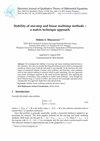T. Godoy
求助PDF
{"title":"奇异狄利克雷椭圆问题的强解","authors":"T. Godoy","doi":"10.14232/ejqtde.2022.1.40","DOIUrl":null,"url":null,"abstract":"<jats:p>We prove an existence result for strong solutions <mml:math xmlns:mml=\"http://www.w3.org/1998/Math/MathML\" xmlns=\"http://www.w3.org/1998/Math/MathML\"> <mml:mi>u</mml:mi> <mml:mo>∈<!-- ∈ --></mml:mo> <mml:msup> <mml:mi>W</mml:mi> <mml:mrow class=\"MJX-TeXAtom-ORD\"> <mml:mn>2</mml:mn> <mml:mo>,</mml:mo> <mml:mi>q</mml:mi> </mml:mrow> </mml:msup> <mml:mrow> <mml:mo>(</mml:mo> <mml:mi mathvariant=\"normal\">Ω<!-- Ω --></mml:mi> <mml:mo>)</mml:mo> </mml:mrow> </mml:math> of singular semilinear elliptic problems of the form <mml:math xmlns:mml=\"http://www.w3.org/1998/Math/MathML\" xmlns=\"http://www.w3.org/1998/Math/MathML\"> <mml:mo>−<!-- − --></mml:mo> <mml:mi mathvariant=\"normal\">Δ<!-- Δ --></mml:mi> <mml:mi>u</mml:mi> <mml:mo>=</mml:mo> <mml:mi>g</mml:mi> <mml:mrow> <mml:mo>(</mml:mo> <mml:mrow> <mml:mo>⋅<!-- ⋅ --></mml:mo> <mml:mo>,</mml:mo> <mml:mi>u</mml:mi> </mml:mrow> <mml:mo>)</mml:mo> </mml:mrow> </mml:math> in <mml:math xmlns:mml=\"http://www.w3.org/1998/Math/MathML\" xmlns=\"http://www.w3.org/1998/Math/MathML\"> <mml:mi mathvariant=\"normal\">Ω<!-- Ω --></mml:mi> <mml:mo>,</mml:mo> </mml:math> <mml:math xmlns:mml=\"http://www.w3.org/1998/Math/MathML\" xmlns=\"http://www.w3.org/1998/Math/MathML\"> <mml:mi>u</mml:mi> <mml:mo>=</mml:mo> <mml:mi>τ<!-- τ --></mml:mi> </mml:math> on <mml:math xmlns:mml=\"http://www.w3.org/1998/Math/MathML\" xmlns=\"http://www.w3.org/1998/Math/MathML\"> <mml:mi mathvariant=\"normal\">∂<!-- ∂ --></mml:mi> <mml:mi mathvariant=\"normal\">Ω<!-- Ω --></mml:mi> <mml:mo>,</mml:mo> </mml:math> where <mml:math xmlns:mml=\"http://www.w3.org/1998/Math/MathML\" xmlns=\"http://www.w3.org/1998/Math/MathML\"> <mml:mn>1</mml:mn> <mml:mo><</mml:mo> <mml:mi>q</mml:mi> <mml:mo><</mml:mo> <mml:mi mathvariant=\"normal\">∞<!-- ∞ --></mml:mi> <mml:mo>,</mml:mo> </mml:math> <mml:math xmlns:mml=\"http://www.w3.org/1998/Math/MathML\" xmlns=\"http://www.w3.org/1998/Math/MathML\"> <mml:mi mathvariant=\"normal\">Ω<!-- Ω --></mml:mi> </mml:math> is a bounded domain in <mml:math xmlns:mml=\"http://www.w3.org/1998/Math/MathML\" xmlns=\"http://www.w3.org/1998/Math/MathML\"> <mml:msup> <mml:mrow class=\"MJX-TeXAtom-ORD\"> <mml:mi mathvariant=\"double-struck\">R</mml:mi> </mml:mrow> <mml:mrow class=\"MJX-TeXAtom-ORD\"> <mml:mi>n</mml:mi> </mml:mrow> </mml:msup> </mml:math> with <mml:math xmlns:mml=\"http://www.w3.org/1998/Math/MathML\" xmlns=\"http://www.w3.org/1998/Math/MathML\"> <mml:msup> <mml:mi>C</mml:mi> <mml:mrow class=\"MJX-TeXAtom-ORD\"> <mml:mn>2</mml:mn> </mml:mrow> </mml:msup> </mml:math> boundary, <mml:math xmlns:mml=\"http://www.w3.org/1998/Math/MathML\" xmlns=\"http://www.w3.org/1998/Math/MathML\"> <mml:mn>0</mml:mn> <mml:mo>≤<!-- ≤ --></mml:mo> <mml:mi>τ<!-- τ --></mml:mi> <mml:mo>∈<!-- ∈ --></mml:mo> <mml:msup> <mml:mi>W</mml:mi> <mml:mrow class=\"MJX-TeXAtom-ORD\"> <mml:mn>2</mml:mn> <mml:mo>−<!-- − --></mml:mo> <mml:mfrac> <mml:mn>1</mml:mn> <mml:mi>q</mml:mi> </mml:mfrac> <mml:mo>,</mml:mo> <mml:mi>q</mml:mi> </mml:mrow> </mml:msup> <mml:mrow> <mml:mo>(</mml:mo> <mml:mrow> <mml:mi mathvariant=\"normal\">∂<!-- ∂ --></mml:mi> <mml:mi mathvariant=\"normal\">Ω<!-- Ω --></mml:mi> </mml:mrow> <mml:mo>)</mml:mo> </mml:mrow> <mml:mo>,</mml:mo> </mml:math> and with <mml:math xmlns:mml=\"http://www.w3.org/1998/Math/MathML\" xmlns=\"http://www.w3.org/1998/Math/MathML\"> <mml:mi>g</mml:mi> <mml:mo>:</mml:mo> <mml:mi mathvariant=\"normal\">Ω<!-- Ω --></mml:mi> <mml:mo>×<!-- × --></mml:mo> <mml:mrow> <mml:mo>(</mml:mo> <mml:mrow> <mml:mn>0</mml:mn> <mml:mo>,</mml:mo> <mml:mi mathvariant=\"normal\">∞<!-- ∞ --></mml:mi> </mml:mrow> <mml:mo>)</mml:mo> </mml:mrow> <mml:mo stretchy=\"false\">→<!-- → --></mml:mo> <mml:mrow> <mml:mo>[</mml:mo> <mml:mrow> <mml:mn>0</mml:mn> <mml:mo>,</mml:mo> <mml:mi mathvariant=\"normal\">∞<!-- ∞ --></mml:mi> </mml:mrow> <mml:mo>)</mml:mo> </mml:mrow> </mml:math> belonging to a class of nonnegative Carathéodory functions, which may be singular at <mml:math xmlns:mml=\"http://www.w3.org/1998/Math/MathML\" xmlns=\"http://www.w3.org/1998/Math/MathML\"> <mml:mi>s</mml:mi> <mml:mo>=</mml:mo> <mml:mn>0</mml:mn> </mml:math> and also at <mml:math xmlns:mml=\"http://www.w3.org/1998/Math/MathML\" xmlns=\"http://www.w3.org/1998/Math/MathML\"> <mml:mi>x</mml:mi> <mml:mo>∈<!-- ∈ --></mml:mo> <mml:mi>S</mml:mi> </mml:math> for some suitable subsets <mml:math xmlns:mml=\"http://www.w3.org/1998/Math/MathML\" xmlns=\"http://www.w3.org/1998/Math/MathML\"> <mml:mi>S</mml:mi> <mml:mo>⊂<!-- ⊂ --></mml:mo> <mml:mover> <mml:mi mathvariant=\"normal\">Ω<!-- Ω --></mml:mi> <mml:mo accent=\"false\">¯<!-- ¯ --></mml:mo> </mml:mover> <mml:mo>.</mml:mo> </mml:math> In addition, we give results concerning the uniqueness and regularity of the solutions. A related problem on punctured domains is also considered.</jats:p>","PeriodicalId":50537,"journal":{"name":"Electronic Journal of Qualitative Theory of Differential Equations","volume":"1 1","pages":""},"PeriodicalIF":0.8000,"publicationDate":"2022-01-01","publicationTypes":"Journal Article","fieldsOfStudy":null,"isOpenAccess":false,"openAccessPdf":"","citationCount":"0","resultStr":"{\"title\":\"Strong solutions for singular Dirichlet elliptic problems\",\"authors\":\"T. Godoy\",\"doi\":\"10.14232/ejqtde.2022.1.40\",\"DOIUrl\":null,\"url\":null,\"abstract\":\"<jats:p>We prove an existence result for strong solutions <mml:math xmlns:mml=\\\"http://www.w3.org/1998/Math/MathML\\\" xmlns=\\\"http://www.w3.org/1998/Math/MathML\\\"> <mml:mi>u</mml:mi> <mml:mo>∈<!-- ∈ --></mml:mo> <mml:msup> <mml:mi>W</mml:mi> <mml:mrow class=\\\"MJX-TeXAtom-ORD\\\"> <mml:mn>2</mml:mn> <mml:mo>,</mml:mo> <mml:mi>q</mml:mi> </mml:mrow> </mml:msup> <mml:mrow> <mml:mo>(</mml:mo> <mml:mi mathvariant=\\\"normal\\\">Ω<!-- Ω --></mml:mi> <mml:mo>)</mml:mo> </mml:mrow> </mml:math> of singular semilinear elliptic problems of the form <mml:math xmlns:mml=\\\"http://www.w3.org/1998/Math/MathML\\\" xmlns=\\\"http://www.w3.org/1998/Math/MathML\\\"> <mml:mo>−<!-- − --></mml:mo> <mml:mi mathvariant=\\\"normal\\\">Δ<!-- Δ --></mml:mi> <mml:mi>u</mml:mi> <mml:mo>=</mml:mo> <mml:mi>g</mml:mi> <mml:mrow> <mml:mo>(</mml:mo> <mml:mrow> <mml:mo>⋅<!-- ⋅ --></mml:mo> <mml:mo>,</mml:mo> <mml:mi>u</mml:mi> </mml:mrow> <mml:mo>)</mml:mo> </mml:mrow> </mml:math> in <mml:math xmlns:mml=\\\"http://www.w3.org/1998/Math/MathML\\\" xmlns=\\\"http://www.w3.org/1998/Math/MathML\\\"> <mml:mi mathvariant=\\\"normal\\\">Ω<!-- Ω --></mml:mi> <mml:mo>,</mml:mo> </mml:math> <mml:math xmlns:mml=\\\"http://www.w3.org/1998/Math/MathML\\\" xmlns=\\\"http://www.w3.org/1998/Math/MathML\\\"> <mml:mi>u</mml:mi> <mml:mo>=</mml:mo> <mml:mi>τ<!-- τ --></mml:mi> </mml:math> on <mml:math xmlns:mml=\\\"http://www.w3.org/1998/Math/MathML\\\" xmlns=\\\"http://www.w3.org/1998/Math/MathML\\\"> <mml:mi mathvariant=\\\"normal\\\">∂<!-- ∂ --></mml:mi> <mml:mi mathvariant=\\\"normal\\\">Ω<!-- Ω --></mml:mi> <mml:mo>,</mml:mo> </mml:math> where <mml:math xmlns:mml=\\\"http://www.w3.org/1998/Math/MathML\\\" xmlns=\\\"http://www.w3.org/1998/Math/MathML\\\"> <mml:mn>1</mml:mn> <mml:mo><</mml:mo> <mml:mi>q</mml:mi> <mml:mo><</mml:mo> <mml:mi mathvariant=\\\"normal\\\">∞<!-- ∞ --></mml:mi> <mml:mo>,</mml:mo> </mml:math> <mml:math xmlns:mml=\\\"http://www.w3.org/1998/Math/MathML\\\" xmlns=\\\"http://www.w3.org/1998/Math/MathML\\\"> <mml:mi mathvariant=\\\"normal\\\">Ω<!-- Ω --></mml:mi> </mml:math> is a bounded domain in <mml:math xmlns:mml=\\\"http://www.w3.org/1998/Math/MathML\\\" xmlns=\\\"http://www.w3.org/1998/Math/MathML\\\"> <mml:msup> <mml:mrow class=\\\"MJX-TeXAtom-ORD\\\"> <mml:mi mathvariant=\\\"double-struck\\\">R</mml:mi> </mml:mrow> <mml:mrow class=\\\"MJX-TeXAtom-ORD\\\"> <mml:mi>n</mml:mi> </mml:mrow> </mml:msup> </mml:math> with <mml:math xmlns:mml=\\\"http://www.w3.org/1998/Math/MathML\\\" xmlns=\\\"http://www.w3.org/1998/Math/MathML\\\"> <mml:msup> <mml:mi>C</mml:mi> <mml:mrow class=\\\"MJX-TeXAtom-ORD\\\"> <mml:mn>2</mml:mn> </mml:mrow> </mml:msup> </mml:math> boundary, <mml:math xmlns:mml=\\\"http://www.w3.org/1998/Math/MathML\\\" xmlns=\\\"http://www.w3.org/1998/Math/MathML\\\"> <mml:mn>0</mml:mn> <mml:mo>≤<!-- ≤ --></mml:mo> <mml:mi>τ<!-- τ --></mml:mi> <mml:mo>∈<!-- ∈ --></mml:mo> <mml:msup> <mml:mi>W</mml:mi> <mml:mrow class=\\\"MJX-TeXAtom-ORD\\\"> <mml:mn>2</mml:mn> <mml:mo>−<!-- − --></mml:mo> <mml:mfrac> <mml:mn>1</mml:mn> <mml:mi>q</mml:mi> </mml:mfrac> <mml:mo>,</mml:mo> <mml:mi>q</mml:mi> </mml:mrow> </mml:msup> <mml:mrow> <mml:mo>(</mml:mo> <mml:mrow> <mml:mi mathvariant=\\\"normal\\\">∂<!-- ∂ --></mml:mi> <mml:mi mathvariant=\\\"normal\\\">Ω<!-- Ω --></mml:mi> </mml:mrow> <mml:mo>)</mml:mo> </mml:mrow> <mml:mo>,</mml:mo> </mml:math> and with <mml:math xmlns:mml=\\\"http://www.w3.org/1998/Math/MathML\\\" xmlns=\\\"http://www.w3.org/1998/Math/MathML\\\"> <mml:mi>g</mml:mi> <mml:mo>:</mml:mo> <mml:mi mathvariant=\\\"normal\\\">Ω<!-- Ω --></mml:mi> <mml:mo>×<!-- × --></mml:mo> <mml:mrow> <mml:mo>(</mml:mo> <mml:mrow> <mml:mn>0</mml:mn> <mml:mo>,</mml:mo> <mml:mi mathvariant=\\\"normal\\\">∞<!-- ∞ --></mml:mi> </mml:mrow> <mml:mo>)</mml:mo> </mml:mrow> <mml:mo stretchy=\\\"false\\\">→<!-- → --></mml:mo> <mml:mrow> <mml:mo>[</mml:mo> <mml:mrow> <mml:mn>0</mml:mn> <mml:mo>,</mml:mo> <mml:mi mathvariant=\\\"normal\\\">∞<!-- ∞ --></mml:mi> </mml:mrow> <mml:mo>)</mml:mo> </mml:mrow> </mml:math> belonging to a class of nonnegative Carathéodory functions, which may be singular at <mml:math xmlns:mml=\\\"http://www.w3.org/1998/Math/MathML\\\" xmlns=\\\"http://www.w3.org/1998/Math/MathML\\\"> <mml:mi>s</mml:mi> <mml:mo>=</mml:mo> <mml:mn>0</mml:mn> </mml:math> and also at <mml:math xmlns:mml=\\\"http://www.w3.org/1998/Math/MathML\\\" xmlns=\\\"http://www.w3.org/1998/Math/MathML\\\"> <mml:mi>x</mml:mi> <mml:mo>∈<!-- ∈ --></mml:mo> <mml:mi>S</mml:mi> </mml:math> for some suitable subsets <mml:math xmlns:mml=\\\"http://www.w3.org/1998/Math/MathML\\\" xmlns=\\\"http://www.w3.org/1998/Math/MathML\\\"> <mml:mi>S</mml:mi> <mml:mo>⊂<!-- ⊂ --></mml:mo> <mml:mover> <mml:mi mathvariant=\\\"normal\\\">Ω<!-- Ω --></mml:mi> <mml:mo accent=\\\"false\\\">¯<!-- ¯ --></mml:mo> </mml:mover> <mml:mo>.</mml:mo> </mml:math> In addition, we give results concerning the uniqueness and regularity of the solutions. A related problem on punctured domains is also considered.</jats:p>\",\"PeriodicalId\":50537,\"journal\":{\"name\":\"Electronic Journal of Qualitative Theory of Differential Equations\",\"volume\":\"1 1\",\"pages\":\"\"},\"PeriodicalIF\":0.8000,\"publicationDate\":\"2022-01-01\",\"publicationTypes\":\"Journal Article\",\"fieldsOfStudy\":null,\"isOpenAccess\":false,\"openAccessPdf\":\"\",\"citationCount\":\"0\",\"resultStr\":null,\"platform\":\"Semanticscholar\",\"paperid\":null,\"PeriodicalName\":\"Electronic Journal of Qualitative Theory of Differential Equations\",\"FirstCategoryId\":\"100\",\"ListUrlMain\":\"https://doi.org/10.14232/ejqtde.2022.1.40\",\"RegionNum\":4,\"RegionCategory\":\"数学\",\"ArticlePicture\":[],\"TitleCN\":null,\"AbstractTextCN\":null,\"PMCID\":null,\"EPubDate\":\"\",\"PubModel\":\"\",\"JCR\":\"Q1\",\"JCRName\":\"MATHEMATICS\",\"Score\":null,\"Total\":0}","platform":"Semanticscholar","paperid":null,"PeriodicalName":"Electronic Journal of Qualitative Theory of Differential Equations","FirstCategoryId":"100","ListUrlMain":"https://doi.org/10.14232/ejqtde.2022.1.40","RegionNum":4,"RegionCategory":"数学","ArticlePicture":[],"TitleCN":null,"AbstractTextCN":null,"PMCID":null,"EPubDate":"","PubModel":"","JCR":"Q1","JCRName":"MATHEMATICS","Score":null,"Total":0}
引用次数: 0
引用
批量引用
Strong solutions for singular Dirichlet elliptic problems
We prove an existence result for strong solutions u ∈ W 2 , q ( Ω ) of singular semilinear elliptic problems of the form − Δ u = g ( ⋅ , u ) in Ω , u = τ on ∂ Ω , where 1 < q < ∞ , Ω is a bounded domain in R n with C 2 boundary, 0 ≤ τ ∈ W 2 − 1 q , q ( ∂ Ω ) , and with g : Ω × ( 0 , ∞ ) → [ 0 , ∞ ) belonging to a class of nonnegative Carathéodory functions, which may be singular at s = 0 and also at x ∈ S for some suitable subsets S ⊂ Ω ¯ . In addition, we give results concerning the uniqueness and regularity of the solutions. A related problem on punctured domains is also considered.

 求助内容:
求助内容: 应助结果提醒方式:
应助结果提醒方式:


